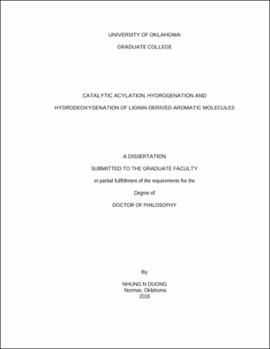| dc.description.abstract | Lignin-derived phenolic molecules are studied for three different chemistries including acylation, hydrogenation and hydrodeoxygenation. Acylation is an effective C-C bond forming reaction to condense acetic acid and lignin-derived aromatic compounds into acetophenones, valuable precursors to fuels and chemicals. However, acetic acid is intrinsically an ineffective acylating agent. Here, we report that its acylation activity can be greatly enhanced by forming intermediate aromatic esters, directly derived from acetic acid and phenolics. Additionally, the acylation reaction was studied in the liquid phase over acid zeolites and was found to happen in two steps, (1) formation of an acylium ion and (2) C-C bond formation between acylium ion and the aromatic substrate. Each one of these steps can be rate-limiting, depending on the type of acylating agent and aromatic substrate. The O-containing substituents such as -OH and -OCH3 can activate aromatic substrates for step (2), with –OH > -OCH3, while alkyl substituent –R cannot. At the same time, the aromatic esters can rearrange to acetophenones via both an intramolecular pathway and, preferentially, an intermolecular one.
Next, the interaction of phenolic molecules with metal surfaces are investigated via two different chemistries: hydrogenation (HY) and hydrodeoxygenation (HDO). Feeding m-cresol over Pt catalyst over a wide range of temperature from 110 to 350℃ shows that m-cresol conversion increases then decreases and later increases again with temperature. This non-linear Arrhenius relationship is found to not happen due to equilibrium limitation or poisoning but rather because of fast drop in m-cresol surface coverage as temperature increases. A Langmuir-Hinshelwood kinetic model is developed for HY reactions of m-cresol to 3-methylcyclohexanone and 3-methylcyclohexanol. Based on this model, the intrinsic energy barrier for of hydrogenation of cresol to ketone is 31 kJ/mol, cresol to alcohol is 26 kJ/mol, ketone to alcohol is 28 kJ/mol. The adsorption enthalpy of m-cresol was found to be 76 kJ/mol with adsorption entropy of 124 J/molK. The binding energy of m-cresol on Pt surface was reported in the literature to be much higher, 180-220 kJ/mol. Based on the kinetic fitting, the adsorption enthalpy and entropy both suggest that the kinetically active species for m-cresol hydrogenation have weakly adsorbed configurations rather than strongly absorbed ones.
At temperature higher than 300℃ on Pt catalyst, m-cresol start to undergo C-O bond cleavage (HDO), creating toluene as the product. Therefore, the conversion of m-cresol starts to increase with temperature after 300℃. Previous studies of m-cresol HDO show that on metals of low oxophilicity, such as Pt or Pd, the direct C-O bond cleavage is not possible. Therefore, HDO requires an indirect pathway via tautomerization. By contrast, on metals of higher oxophilicity, such as Ru or Rh, the direct C-O bond cleavage is possible, and toluene can be directly obtained from m-cresol. These studies show that the HDO activity correlates directly with the metal oxophilicity, which in turn depends on the position of the d-band center relative to the Fermi level. This catalytic descriptor depends on (1) type of metal and (2) extent of coordination of the metal atoms. In the last part of this study, the effect of the second factor will be investigated. It is demonstrated that a Rh/SiO2 catalyst with small particles (low coordination sites) is more active for HDO than one with larger particles (high coordination sites). At the same time, the low coordination site is more prone to deactivation and loss of HDO selectivity. These experimental results are combined with the DFT calculations, which show that the energy barrier for direct C-O bond cleavage is lower on a step site than on a terrace site. At the same time, it is shown that a step site requires a higher energy barrier to remove adsorbed molecular fragments to regenerate the activity than a terrace site, which explains the faster deactivation rate observed on catalysts with small, more defective metal clusters. | en_US |
